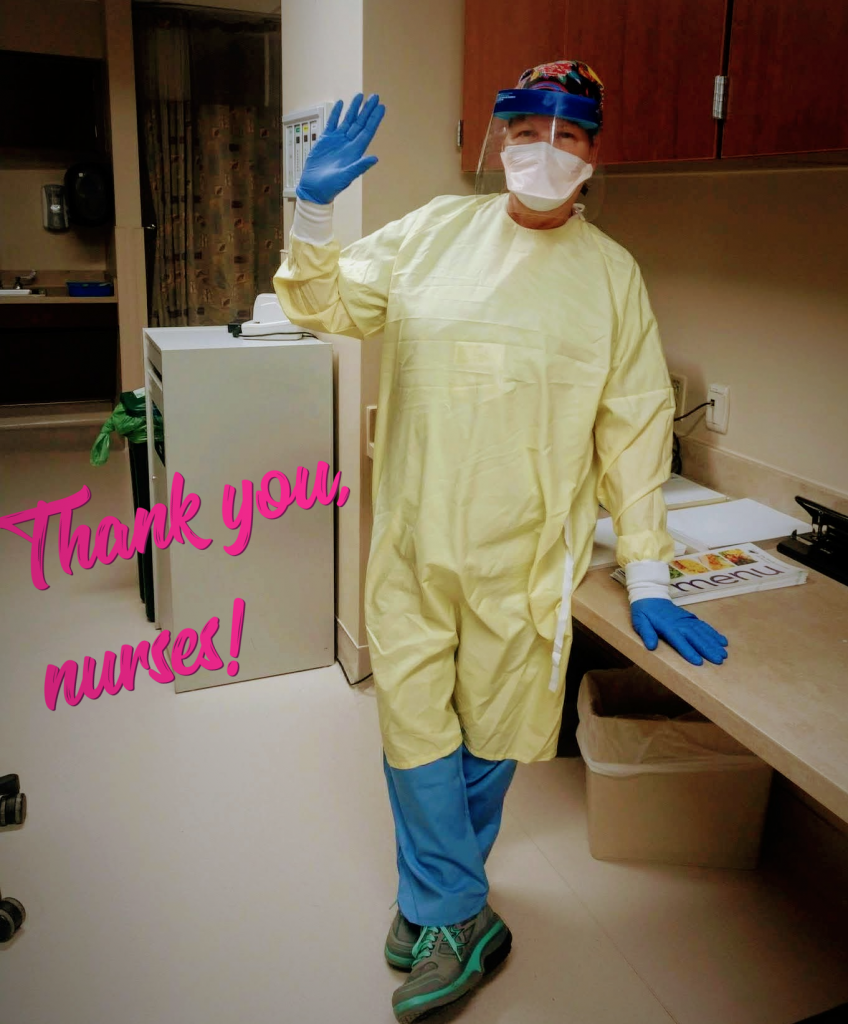On Nurse’s Day this year, I am even more thankful for and inspired by the work that my mother, Kathy Borowy, does as an ICU Nurse. Thank you, Mom, for sharing your story, and thank you to all the nurses caring for critically ill patients in hospitals across the country, every day.

My day starts at 3:30 a.m., when I wake up for my 5 a.m. – 5 p.m. shift at the hospital. My breakfast and lunch have been packed the night before and I leave home with my hair pulled back in a scrub cap and wearing my scrubs.
When I arrive at the ICU, I pick up my plastic bin, containing my N-95 mask. I’m given a set of hospital scrubs that I change into, and a pack of 12 plastic gowns, then head into the unit to take report for my assignment. Before COVID, gowns and masks were changed with each exposure to any isolation patient. Sometimes, that could be up to 10 gowns an hour! Today, our N-95 masks are reused and UV-lighted for conservation. It’s all about preservation of these precious resources now; not knowing how long this will last, we want to stay prepared.
The process of “gowning up” involves foaming with a disinfectant or washing your hands, putting on a plastic gown, an N-95 mask, my face shield, and gloves. When you get to be really proficient it takes less than two minutes to get everything on in the right place.
These are hard, stressful, 12-hour shifts. It can get hot and sticky inside the plastic gowns, and our minds are always going:
What meds do I need to give?
Do I have back-up bags of essential fluids, vasopressors and sedatives?
Will I be ready for team rounds?
Are there linens and trash bags in the room?
Why is that ventilator alarming, are the settings correct?
Did the tubing come disconnected?
Does my patient need to be suctioned?
Going inside a COVID-positive ICU room is not a trivial feat. Once you gown up, and you’re in that room, you want to get everything done. Nurses are responsible for not only the patient care and their safety but also the environment. To limit exposure, most support services such as housekeeping, dietary, pharmacy and lab don’t enter these isolation rooms, so nurses pick up these responsibilities. We find ourselves “kindly” shouting at our colleagues through the glass doors of noisy negative-airflow isolation rooms if we need something on the outside that we forgot to bring in. Teamwork is everything!
When you’re ready to leave a room, you take off your gown and gloves in that room and dispose of them there, then wash your hands. You open the door with your foot or elbow and exit the room. Once outside, you put on a clean pair of gloves, take off your face shield, wipe it down with disinfectant, and put it in your paper bag. Then take off your N-95 and put it in the bag. Remove and discard the gloves you just put on because they’ve touched your potentially contaminated N-95 and face shield. Foam or wash your hands again. Finally, I put on reading glasses, plastic goggles, and a standard procedure mask. It is a process. And one that doctors and nurses take very seriously.
Nurses aren’t just nurses, you’re kind of everything for the patient.
Physicians go into isolation rooms, but only when necessary. And it makes sense, the fewer people exposed, the better. I overheard one physician say to another who was about to enter a room, All the information you need, I can give you or you can get it from the nurse. If you don’t need to go in the isolation room, don’t do it.
One of the hardest things nurses experience is when a patient is dying. You never let a patient die alone. You’re always there to hold their hand. The nurse needs to be there to hold that patient’s hand. Sometimes, though, I can’t even look dying patients in the eye anymore; it’s just so hard. The best I can do is stand next to them, with my hand on their shoulder. They’re probably wondering, Where is my family? Why aren’t they with me now? As I stand next to them, I tell them, Your family loves you, it’s ok, now you can go in peace.
The news media call us heroes.
I don’t see myself as a hero.
I just go to work, like so many of my colleagues. The real heroes are the survivors and their families. We have “graduation” parades down the hall when a patient is transferred from ICU to the floor or, better yet, goes home. Heroes are the families going through the loss of their loved ones; it is an honor to care for them.
Critical care is what I do. I’ve done this for 26 years, and I still love it! I feel so fortunate to have a career I just love. In the early mornings, I get up and give thanks that I have another opportunity to go in to do this work. I ask for courage and strength to get through the struggles. We’ve only had four ICU nurses get sick, out of 120 or so, and I’m grateful for that.
When I get home, I pull in, take off my scrubs in the garage, leave my shoes in the garage, and take my clothes to the washing machine. Straight to the shower, maybe a bite to eat and then I crash.
Knowing I have a high exposure to this virus, I’m home alone and don’t interact with anyone outside of work. So, it is a bit lonely. On my days off, I try to be productive; sometimes I am and sometimes I’m not. It’s one extreme to the other … the intensity of work or the complete silence at home. I miss my family and friends. I miss swimming. I just miss normal life.
Thank you to everyone who has donated hot meals to hospital staff, to the children who have sent us cards and drawings, and especially for the words of thanks and encouragement we receive both inside the hospital and out. It keeps us going.

















I love your story, Jen. And Kathy, thank you for the care and love I know you provide each and every patient. We are thankful for you and your colleagues always but especially during these most trying times. You are in my prayers.